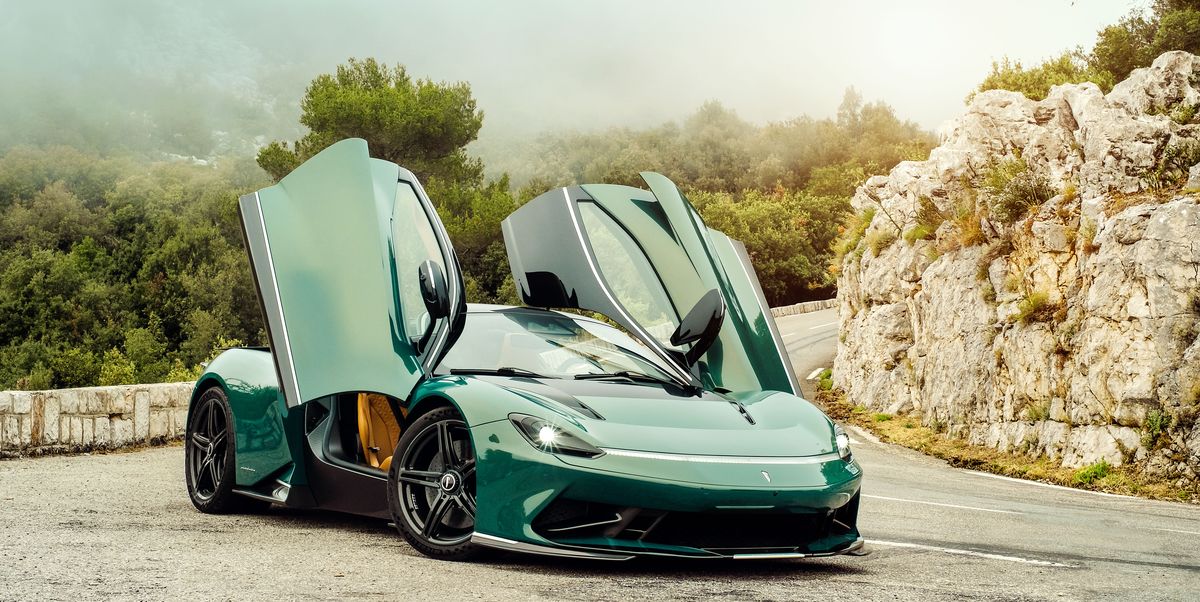1900-HP Pininfarina Battista Going into Production, Coming to U.S.

The most powerful Italian car in history is finally in official production mode. The Pininfarina Battista, whose electric motors drive 1900 horsepower and 1725 pound-feet of torque to all four wheels, famously shares roots with the Rimac Nevera. But nearly a year following our first drive, a series of tweaks and refinements have since put a finer point on the $1.99 million hypercar, which the Mahindra-owned manufacturer says will reach U.S. garages later this year.
“We’ve improved the performance aspects and gained consistency with reliability and durability,” chief product and engineering officer Paolo Dellachà told Car and Driver. “During the last 11 months we’ve also been fine tuning the e-powertrain, chassis calibration, ESC, and torque vectoring,” he adds. “I can tell you it is more refined and way faster than when you drove it [11 months ago].”
That last bit is a gobsmacking claim. On paper, Pininfarina reports a zero-to-60-mph time of 1.8 seconds and an electronically limited top speed of 217 mph, both of which remain unchanged. Incidentally, Battista feels even quicker by the seat of the pants than the figures suggest. Dellachà says the car is now faster around a racetrack due to improvements at corner exit and power delivery. However, we’re inclined to believe the average Battista buyer might not be hot to trot the multi-million-dollar EV with hot laps at their local circuit.
Pininfarina’s first nameplate since the Azzurra in the mid-1980s claims incremental distinctions over the Nevera, including a signature sound and a literal hum, which vibrates at 54 hertz. Just-released homologation details reveal the Battista is EPA rated at 300 miles of combined range (290 City/309 Highway), edging out the Nevera’s 287 combined figure. Pininfarina also boosted its official torque figure by 29 lb-ft, while the Nevera takes the power crown with 1,914 hp. Dellachà says that DC quick charging has also been upped from 180-kW to 250-kW, and the 5 drive modes are now individually customizable.
Battista honors its design house roots by bringing a bit of Italianate flair its Croatian counterpart’s straight-laced treatment. It’s a tipping point that likely serves as a strong draw for buyers like serial supercar collector and first customer Luciano Colosio, who told Financial Times that he has at one time owned a McLaren F1, Bugatti Veyron, two Aston Martin One-77s, and numerous Ferraris. The publication says Colosio once had a strict V-12-only policy, but has since shifted his viewpoint on electron-powered supercars— a cleverly leveraged preference that bolsters the argument for ultra-high-performance battery electric vehicles.
Chief designer Dave Battista, who is working individually with each buyer to spec their Battistas, says the exterior can be configured in up to 13.9 quintillion configurations. Only 150 units will be produced in total, which helps explain why the boutique builder estimates 10 weeks to build each Battista at their Cambiano, Italy, facility. The hand-painted Anniversario spec extends that time frame to 18 weeks.
Pininfarina also released details on three after-sales packages. Eccellenza offers five or 10 years of maintenance for “providing optimum performance and safeguarding its warranty and value,” at $72,000 or $145,000 respectively; Futura extends the battery and powertrain warranty an additional 7 years (for a total of 10 years) for $150,000; and the Eterna package includes a set of replacement body parts in the unfortunate event that they’re needed. Pricing for the extra bodywork depends on the ordered vehicle’s specs.
Watch this space for updates when we take a closer look at Pininfarina Battista at Monterey Car Week in August, and get behind the wheel for a drive of the final production-spec car.
This content is created and maintained by a third party, and imported onto this page to help users provide their email addresses. You may be able to find more information about this and similar content at piano.io



